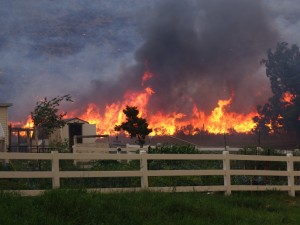Population growth and the expanding urban development into traditionally nonurban areas have increasingly brought humans into contact with wildfires. In the decade ending with 1994, wildfires destroyed more than 9,000 homes in the United States. Generally, these homes were located in areas where structures and other human developments meet or intermingle with undeveloped wildland or vegetative fuels, also known as the Wildland Urban Interface.
 The International Wildland-Urban Interface Code (IWUIC) is a model code intended to be adopted and used to supplement the adopted building and fire codes of a Building Permit issuing jurisdiction. The IWUIC has as its primary objective the establishment of minimum specific regulations for the safeguarding of life and property from intrusion of fire from wildland fire exposures and fire exposures from adjacent structures and to prevent structure fires from spreading to wildland fuels, even in the absence of fire department intervention.
The International Wildland-Urban Interface Code (IWUIC) is a model code intended to be adopted and used to supplement the adopted building and fire codes of a Building Permit issuing jurisdiction. The IWUIC has as its primary objective the establishment of minimum specific regulations for the safeguarding of life and property from intrusion of fire from wildland fire exposures and fire exposures from adjacent structures and to prevent structure fires from spreading to wildland fuels, even in the absence of fire department intervention.
Many Building Departments, which have adopted the IWUIC, have informational handouts which give guidelines as to how to conform to the requirements.
Below are some of the provisions which affect post frame (pole) building construction.
Roofs: Shall have at least a Class A roof covering, or an approved noncombustible roof covering. Steel roofing is Class A rated. For ribbed steel roofing panels, the space at the eave ends shall be fire-stopped to preclude entry of flames or embers, or have one layer of 72-pound mineral surfaced, non-perforated cap sheet complying with ASTM D 3909.
Roof valleys: When provided shall be not less than 26 gauge or corrosion resistive materials metal installed over a minimum 36 inches wide underlayment consisting of one layer of 72-pound mineral surfaced, non-perforated cap sheet complying with ASTM D 3909 running the full length of the valley.
Protection of eaves: Eaves and soffits shall be protected on the exposed underside by materials approved for a minimum of 1-hour fire-resistance-rated construction, 2-inch nominal dimension lumber, or 1-inch nominal fire-retardant-treated lumber or 3/4-inch nominal fire retardant-treated plywood, identified for exterior use and meeting the requirements of the International Building Code.
In my humble opinion, the Building Official should be queried as to the acceptability of solid steel soffit panels, as they will not combust.
Fasciae: Are required and shall be protected on the backside by materials approved for a minimum of 1-hour fire-resistance-rated construction or 2-inch nominal dimension lumber.
Steel fascia trims applied over 2x fascia boards will meet this requirement, and would be generally typical construction.
Exterior walls: Exterior walls of buildings or structures shall be constructed with one of the following methods:
- Materials approved for a minimum of 1-hour fire-resistance-rated construction on the exterior side.
- Constructed with approved noncombustible materials.
- Heavy timber or log wall construction.
- Fire-retardant treated wood on the exterior side.
- Ignition-resistant materials on the exterior side.
Such material shall extend from the top of the foundation to the underside of the roof sheathing.
We’ve had no issues with the approval of steel siding, however we did have a case in California where the Building Official required the exposed portion of the 2×8 pressure preservative treated splash board to be covered with steel trim. In most cases, the splash board would be considered to be a portion of the foundation.
Exterior window glazing: Exterior windows, window walls and glazed doors, windows within exterior doors, and skylights shall be tempered glass, multilayered glazed panels, glass block or have a fire protection rating of not less than 20 minutes.
Many vinyl windows with tempered glass meet with these requirements.
Exterior doors: Exterior doors shall be approved noncombustible construction, solid core wood not less than 1-3/4 inches thick or have a fire protection rating of not less than 20 minutes. Windows within doors and glazed doors shall be in accordance with exterior window glazing listed above.
Most commercial steel entry doors with steel jambs are satisfactory. Even though a solid core wood door might meet with the fire protection rating, chances are the door is mounted in wood jambs, which will probably not be acceptable within the fire code.
Exception: Vehicle access doors.
And then there is ventilation, sprinklers and more! Come back tomorrow and we’ll get to the rest of meeting the International Wildland-Urban Interface Code.






